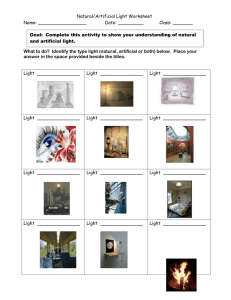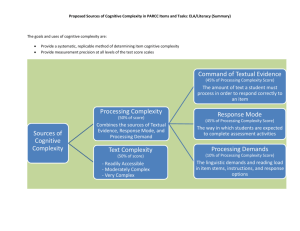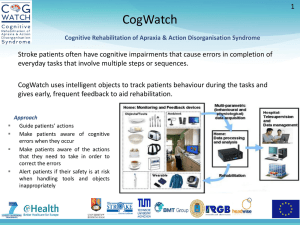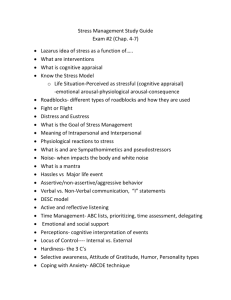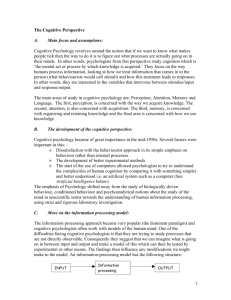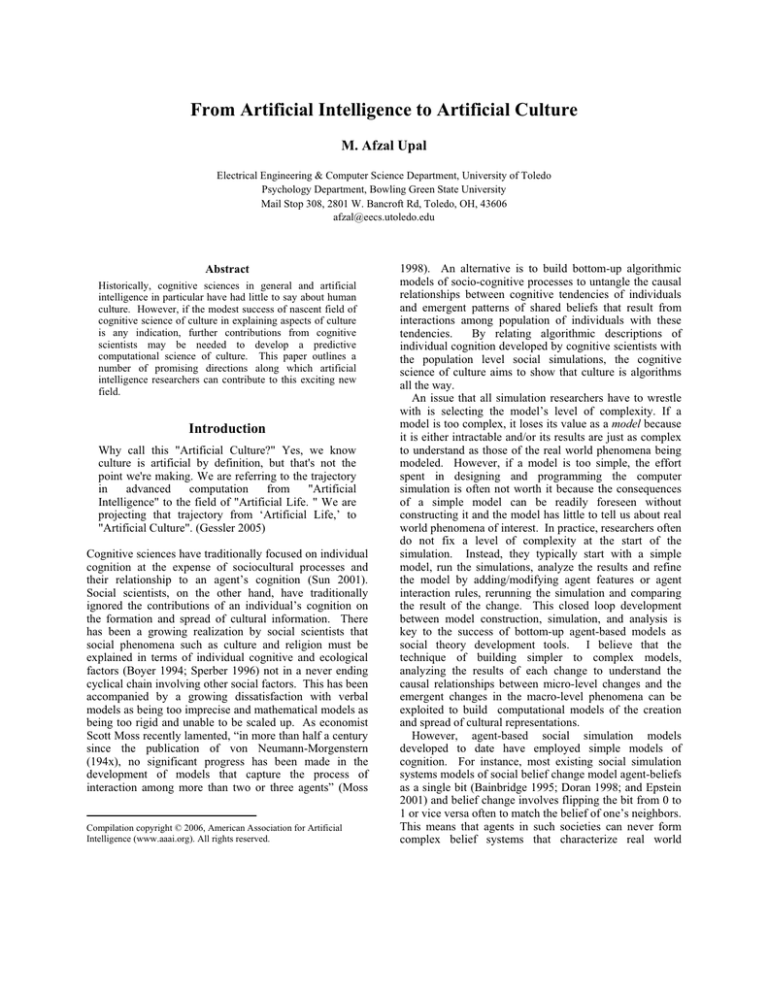
From Artificial Intelligence to Artificial Culture
M. Afzal Upal
Electrical Engineering & Computer Science Department, University of Toledo
Psychology Department, Bowling Green State University
Mail Stop 308, 2801 W. Bancroft Rd, Toledo, OH, 43606
afzal@eecs.utoledo.edu
Abstract
Historically, cognitive sciences in general and artificial
intelligence in particular have had little to say about human
culture. However, if the modest success of nascent field of
cognitive science of culture in explaining aspects of culture
is any indication, further contributions from cognitive
scientists may be needed to develop a predictive
computational science of culture. This paper outlines a
number of promising directions along which artificial
intelligence researchers can contribute to this exciting new
field.
Introduction
Why call this "Artificial Culture?" Yes, we know
culture is artificial by definition, but that's not the
point we're making. We are referring to the trajectory
in
advanced
computation
from
"Artificial
Intelligence" to the field of "Artificial Life. " We are
projecting that trajectory from ‘Artificial Life,’ to
"Artificial Culture". (Gessler 2005)
Cognitive sciences have traditionally focused on individual
cognition at the expense of sociocultural processes and
their relationship to an agent’s cognition (Sun 2001).
Social scientists, on the other hand, have traditionally
ignored the contributions of an individual’s cognition on
the formation and spread of cultural information. There
has been a growing realization by social scientists that
social phenomena such as culture and religion must be
explained in terms of individual cognitive and ecological
factors (Boyer 1994; Sperber 1996) not in a never ending
cyclical chain involving other social factors. This has been
accompanied by a growing dissatisfaction with verbal
models as being too imprecise and mathematical models as
being too rigid and unable to be scaled up. As economist
Scott Moss recently lamented, “in more than half a century
since the publication of von Neumann-Morgenstern
(194x), no significant progress has been made in the
development of models that capture the process of
interaction among more than two or three agents” (Moss
Compilation copyright © 2006, American Association for Artificial
Intelligence (www.aaai.org). All rights reserved.
1998). An alternative is to build bottom-up algorithmic
models of socio-cognitive processes to untangle the causal
relationships between cognitive tendencies of individuals
and emergent patterns of shared beliefs that result from
interactions among population of individuals with these
tendencies.
By relating algorithmic descriptions of
individual cognition developed by cognitive scientists with
the population level social simulations, the cognitive
science of culture aims to show that culture is algorithms
all the way.
An issue that all simulation researchers have to wrestle
with is selecting the model’s level of complexity. If a
model is too complex, it loses its value as a model because
it is either intractable and/or its results are just as complex
to understand as those of the real world phenomena being
modeled. However, if a model is too simple, the effort
spent in designing and programming the computer
simulation is often not worth it because the consequences
of a simple model can be readily foreseen without
constructing it and the model has little to tell us about real
world phenomena of interest. In practice, researchers often
do not fix a level of complexity at the start of the
simulation. Instead, they typically start with a simple
model, run the simulations, analyze the results and refine
the model by adding/modifying agent features or agent
interaction rules, rerunning the simulation and comparing
the result of the change. This closed loop development
between model construction, simulation, and analysis is
key to the success of bottom-up agent-based models as
social theory development tools. I believe that the
technique of building simpler to complex models,
analyzing the results of each change to understand the
causal relationships between micro-level changes and the
emergent changes in the macro-level phenomena can be
exploited to build computational models of the creation
and spread of cultural representations.
However, agent-based social simulation models
developed to date have employed simple models of
cognition. For instance, most existing social simulation
systems models of social belief change model agent-beliefs
as a single bit (Bainbridge 1995; Doran 1998; and Epstein
2001) and belief change involves flipping the bit from 0 to
1 or vice versa often to match the belief of one’s neighbors.
This means that agents in such societies can never form
complex belief systems that characterize real world
cultures and hence such simulations can tell us little about
human cultures. Further, there is considerable evidence to
suggest that the ability to produce and comprehend natural
language narratives is crucial to the formation and
propagation of cultural knowledge. Being able to generate
and comprehend natural language requires rich knowledge
representation and deep reasoning capabilities including
planning, knowledge acquisition, belief revision, and
comprehension. The new cognitive science of culture
investigates how cultural contexts affect individual thought
and how individual cognitive tendencies result in the
emergence of cultural patterns.
I believe that artificial intelligence can play a central role
in the new cognitive science of culture by not only
providing agent-based computer modeling tools that allow
social scientists to explore and test their theories but also
by providing a level of abstraction that is removed enough
from case studies of particular sociocognitive processes to
allow one to see the important similarities between them
and discover patterns invisible to the social scientists. This
approach can allow us to ask and answer new questions. I
illustrate this approach with the help of the analysis of
communication between agents- a process whose
understanding is key to the understanding of the creation
and spread of cultural ideas.
Human Communications
Communicate. We humans do it all the time, and most
of the time we do it as a matter of course, without
thinking about it. We talk, we listen, we write, we
read - as you are doing now - or we draw, we mimic,
we nod, we point, we shrug, and, somehow, we
manage to make our thoughts known to one another…
compared to other living kinds, we are amazingly
good at it. Other species, if they communicate at all,
have a narrow repertoire of signals that they use to
convey again and again things like: "this is my
territory," "danger, run!" or "ready for sex."
(Sperber 1995)
One of the basic causes for all the trouble in the world
today is that people talk too much and think too little.
(Margaret Chase Smith)
People say conversation is a lost art; how often I have
wished it were!
(Edward R. Morrow)
As Sperber and others have noted, people appear to be
eager communicators. They appear eager (sometimes too
eager) to speak and eager to comprehend (sometimes so
eager that they see patterns where there really aren’t any).
Editors of any mailing list, newsgroup, newspaper,
magazine or tv/radio call in show know that regardless of
the topic, there are always more people willing to speak for
longer than the limited resources allow. Given the fact that
it is hard to find any two humans within a close range of
each other not communicating with each other in one form
or another, it is surprising how little work has been done to
investigate the reasons as to why that is.
-
Why do people appear to be eager speakers?
Why do people appear to be eager listeners?
As Richerson and Boyd (1985) argue evolution is the
ultimate answer to why questions about human mind and
behavior. The problem for evolutionary scientists is to
uncover the computational advantages that a behavior
confers upon its practitioners as compared to the nonpractitioners. In this light, the above questions can be
reframed as:
-
What evolutionary advantages did the eagerness
to speak confer upon our evolutionary ancestors?
What evolutionary advantages did the eagerness
to listen confer upon our evolutionary ancestors?
While such questions are certainly interesting in their own
right they are also interesting because answers to such
questions are needed in order to build a cognitive science
of culture that relates pragmatics of individual
communication to the creation and spread of culture
allowing us to build a natural history of various cultural
ideas. Such questions should be of interest to evolutionary
theorists who propose that in order for ideas- or memes- to
become cultural i.e., widely shared by a population, they
have to have something about them that allows them to
replicate themselves more effectively than other ideas.
Because of the notorious complexity of the vast number
of interacting variables involved, it is best to abstract out
the key processes as much as possible and analyze them as
computational processes. The problem solving paradigm
of Newel and Simon (1972) provides an effective
abstraction. This view characterizes the environment
inhabited by our evolutionary ancestors as a problem
solving environment which frequently called upon its
inhabitants to make accurate predictions in order to secure
resources, to safely negotiate their way, and to avoid
falling prey to various predators.
In a dynamically changing environment, the adaptive
agents that can modify their problem solving strategies and
their world model have an advantage over their
competitors in terms of being able to better predict their
environment and thereby obtain access to more resources
and pass on their strategies and learned knowledge to their
descendents. Such adaptive agents should not only learn
from their own interaction with the world but they should
also be open to learning from others when opportunities
arise. However, this raises several problems such as how
to evolve a common language with a commonly agreed
upon syntax and semantics. Much of the work on
computational pragmatics (Bunt & Black 2000) addresses
these questions. However, even if we assume that the
communicating agents share a common language, a listener
still needs to engage in an effort to try to comprehend the
information provided by a speaker. This effort has
significant computational costs such as the cost of
understanding the meaning of the message and the cost of
updating the agent’s world model in light of the
information derived from the message. The agent has to
devote precious time and cognitive resources to processing
the message. Such preoccupation can result in immobility
potentially costing an agent its life. Therefore, a rational
agent should only engage in such an effort if the estimated
benefits of such an effort outweigh its estimated costs.
Thus a speaker should compare the estimated benefits of
performing the utterance action to communicate a piece of
information with the cost of performing such an action to
decide whether to speak or not. A listener should compare
the estimated benefits of processing a message with
estimated costs of processing it before actually
comprehending it.
While some have advanced alternative architectures
(Brooks 1991), most cognitive scientists believe that a
problem solving agent has to build internal representation
of its environment (the so called world model) to be
successful in solving various problem posed by its
environment. A message received from another agent is
beneficial to such an agent if it leads to a more predictive
model of the world.
The problem however, is that before comprehending the
meaning of a message an agent has little information
available to estimate the costs and benefits of processing a
message. This suggests a multi-phased approach. A
rational agent should exploit all the information at its
disposal when it receives the message (without actually
processing the message) to estimate the benefits and costs
of processing the message and start the first phase of
processing if it believes that benefits outweigh the costs.
This information could include the context in which the
listeners receives the information and the mental state of
the listener. On receiving two messages simultaneously, a
rational listener should prefer to process the message
received from the more reliable and trustworthy agent.
Similarly, an agent should be less willing to process a long
message if all its cognitive resources are being consumed
in a potentially deadly fight with a predator. If the benefits
of engaging in the first phase of comprehension outweigh
the costs, the agent should start the first phase.
At the completion of the first phase, however, a rational
listener should use the newly derived information to
compute the estimates and costs of further processing and
only continue if benefits of further processing outweigh the
its costs. An agent can use the information derived during
the process of natural language understanding (this
includes both the meaning of the message (the objective of
natural language understanding) and also any ancillary
information the agent may obtain as by-product of
comprehension such as the background knowledge that is
activated during the meaning computation process to
compute a better estimates of the benefits and costs of
further processing the message to revise the agent’s world
model in light of the message.
A message that does not lead to any improvements in an
agent’s world model would be of little benefit to an agent.
For instance, a message that conforms to all the agent’s
expectations and hence will not likely lead to any changes
in the listener’s world model should be discounted for
further processing. Similarly, a message that violates so
many expectations that the agent cannot make any sense
out of it should also be discounted. A message in the
intermediate range, however (i.e., a message that does not
conform to all expectations but can be assigned a meaning
with some effort) should be estimated as likely to provide
significant new information i.e., result in information gain.
If we define postdictability of a message as the ease with
which a listener can compute the meaning of that message
and predictability of a message as the ease with which the
listener can create that message using its existing world
model then the difference between the two quantities give
us an estimate of the benefit of further processing the
message to revise one’s world model.
Our model predicts that rational listeners should bias
their comprehension process to process those messages
maximally that have the largest difference in
postdictability and predictability values. Over the last few
years we have performed a number of experiments with
human subjects to see whether people’s comprehension of
various concepts corresponds to the predictions of the
rational listener model outlined above (Upal 2004; Upal
2005; Owsianiecki, Upal, Slone, & Tweney 2006; Tweney,
Upal, Owsianiecki, Slone submitted; Slone, Upal,
Owsianiecki, Tweney, submitted). Our findings are similar
to those of a number of earlier studies (Boyer & Ramble
2001; Barrett & Nyhoff 2001; Atran 2003) that show that
people better remember minimally counterintuitive
concepts as compared to the intuitive and maximally
counterintuitive concepts. Boyer (1994) has argued that
this helps explain as to why minimally counterintuitive
ideas are so widespread among the world religions in
particular and in popular culture in general. Minimally
counterintuitive ideas are so prevalent in emergent cultural
phenomena because they are preferentially processed by
individuals.
This appears to be obviously true if everything else is
equal.
As students of culture are painfully aware
everything else is never equal in the real world. The
complexity of culture, in part due to a large number of
interacting factors, has so far thwarted any meaningful
progress towards a detailed predictive model of the spread
of cultural ideas. Besides counterintuitiveness there are a
number of other factors that are also known to impact
memorability of an idea such as imagery, and concreteness
(Sadoski and Paivio 2001), and the emotional state of the
comprehendor, to see how they may be impacting
memorability of intuitive and counterintuitive concepts.
Imagery and concreteness are known to be positively
correlated with each other as well as with memorability.
However, it is not known how these variables relate to
counterintuitivess and how imagery, concreteness, and
counterintuitivess jointly relate to memorability. Some
work in progress (Slone, Owsianiecki, Upal, Tweney, &
Edwards, in preparation) suggests that counterintuitiveness
may insulate a concept from the usual effects of imagery.
Moreover, a number of other factors besides memorability
are though to have an impact on how well an idea spreads
in a population (Atran 2003). For instance, Bainbridge and
Stark (1987) argue that unconfirmable ideas have an
advantage in terms of being believed by individuals and
spreading in a population.
I believe that cognitively-rich agent-based social
simulation models can be helpful in understanding the
relationship between the myriad of factors thought to affect
formation and spread of culture. To this end, we have
designed a testbed multiagent society that inhabits a
version of Russell & Norvig’s (1995) Wumpus World
(WW). Our version of WW has 100 (10 x 10) cells and is
inhabited by ten agents randomly placed at ten cells at the
start of the game. Agents navigate the world by moving
one cell at a time horizontally or vertically. An agent dies
if it falls into a pit and another agent is created to take its
place. Agents like visiting cells with treasure in them and
try to avoid falling into pits which emit smell that can be
perceived in the neighboring cells. Agents perceive their
environment and reason with it to build and refine their
world model. The world model, in the current version,
only contains the cell locations they believe contain pits or
treasures in them. On perceiving the smell, they assume
that all the neighboring cells (except the cells they’ve
already visited) contain a pit in them. On hearing an
agent’s 'yipee’, they assume that all the neighboring cells
(except the ones they’ve already visited and do no contain
treasures) have treasures.
Thus agent models may contain inaccuracies both about
the locations of the pits as well the locations of the
treasure. However, there’s an asymmetry between the
treasures and pits. While the agents prefer to travel
towards a cell where they expect to find treasure, they
avoid cells they believe contain pits in them. The result is
that the agent never have the ability to revise their beliefs
about the presence of pits through their own observations.
This results agents abandoning their beliefs about phantom
treasures as they travel more and more though WW but
they are never able to do so for their beliefs in phantom
pits. Our results show that the proportion of false pit
beliefs to the total number of pit beliefs remains constant
regardless of how much the agents travel in the world.
This seems to be similar to what is predicted by Bainbridge
and Stark (1987)’s theory of religion, namely, that
untestable beliefs have cognitive advantages and this leads
to more widespread new religious movement beliefs being
of this variety.
We plan to carefully add reasoning and knowledge
representation capabilities to our testbed evaluating the
results of each change to discover causal relationships
between cognitive and ecological factors and emergent
social phenomena.
Conclusion
This paper illustrates our strategy for building a
computational science of culture. It involves analyzing the
interaction of knowledge among a society of rational
problem solving agents aided by agent-based social
simulation of cognitively rich agent societies. This is to be
done in conjunction with the study of individual and group
human behavior to find the points in the space of artificial
cultures where human cultures lie. I believe that this
approach has the best hope of leading us to a predictive
computational model of the formation and propagation of
cultural information.
References
Atran, S. 2002. In Gods We Trust: The Evolutionary
Landscape of Religion, Oxford, NY: Oxford University
Press.
Bainbridge, W. 1995. Neural Network Models of Religious
Belief , Sociological Perspectives, 38: 483-495.
Bainbridge, W. & Stark, R. 1987. A Theory of Religion,
New York: Lang.
Barrett, J. L. & Nyhof, M. (2001). Spreading Non-natural
concepts: the role of intuitive conceptual structures in
memory and transmission of cultural materials. Journal of
Cognition and Culture, 1, 69-100.
Boyer, P. (1994). The Naturalness of Religious Ideas: A
Cognitive Theory of Religion, Berkeley, CA: University of
California Press.
Boyer, P. & Ramble, C. (2001). Cognitive templates for
religious concepts. Cognitive Science, 25, 535-564.
Brooks, R. A. (1991), Intelligence without representation,
Artificial Intelligence, (47), 139–159
Bunt, H. & Black, W. 2000. Abduction, Belief and Context
in Dialogue: Studies in Computational Pragmatics,
Amsterdam: John Benjamins Publishing Co.
Castelfranchi, C. 2001. Towards cognitive memetics:
Socio-cognitive mechanisms for meme selection and
spreading, Journal of Memetics - Evolutionary Models of
Information Transmission, vol. 5.
Doran, J. (1998). Simulating collective misbelief, Journal
of Artificial Societies and Social Simulation, 1(1).
Epstein, J. & Axtell, R. (1996). Growing Artificial
Societies: Social Sciences from the Bottom Up,
Washington, DC: Brookings Institute Press.
Epstein, J. (2001). Learning to be thoughtless: Social
norms and individual computation, Computational
Economics, 18(1), 9-24
Gessler, N. 2005. Lecture Notes for UCLA Anthropology
137, http://www.sscnet.ucla.edu/geog/gessler/2005-acult/7
Newell, A. & Simon, H. (1972). Human Problem Solving,
Englewood Cliffs, NJ: Prentice-Hall.
Owsianiecki, L., Upal, M., Slone, J., & Tweney, R. (2006,
in press). The role of context in the recall of
counterintuitive concepts. Journal of Cognition and
Culture.
Richerson, P.J. & Boyd, R. (2005). Not by genes alone:
How culture transformed human evolution. Chicago:
University of Chicago Press.
Sadoski, M. & Paivio, A. (2001). Imagery and text: a dual
coding theory. Mahwah, NJ: Erlbaum
Sperer, D. 1995. How do we communicate? in John
Brockman & Katinka Matson (eds) How things are: A
science toolkit for the mind. New York: Morrow, 191-199.
Sperber, D. 1996. Explaining Culture: A Naturalistic
Approach, Malden, MA: Blackwell Publishers.
Sun, R. 2001. Cognitive science meets multi-agent
systems: A prolegomenon. Philosophical Psychology,
Vol.14, No.1, pp.5-28.
Tweney, R.D., Upal, M.A., Owsianiecki, L., Slone, D.J. &
Edwards, K. (in press, 2007). The creative structuring of
counterintuitive worlds. Journal of Cognition and Culture,
vol. 7.
Upal, M. A. (2005b). Simulating the Emergence and
Maintenance of NRMs, in Journal of Artificial Societies
and Social Simulation, 8(1).
Upal, M. A. (2004). Computational Modeling of the
Acquisition of Counterintuitive Concepts in Proceedings of
the Fifth International Conference on Cognitive Modeling,
pages 392-393, Mahwah, NJ: Lawrence Erlbaum

